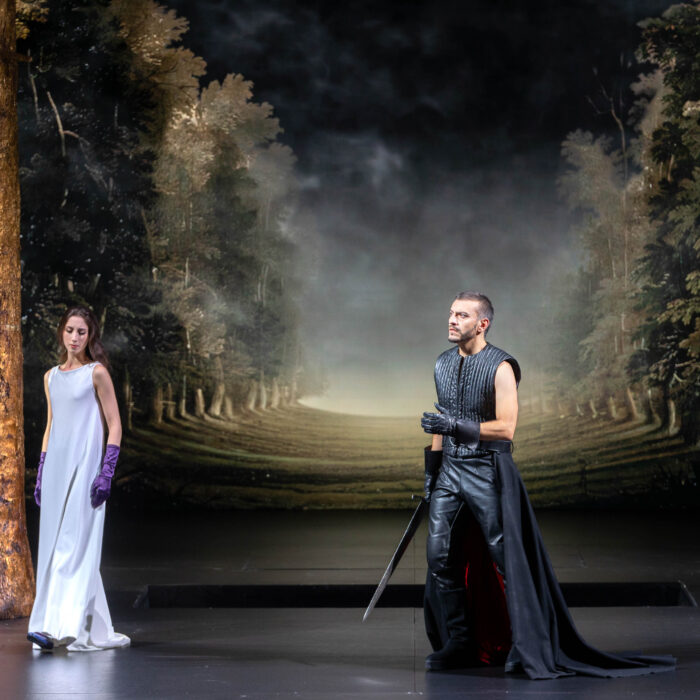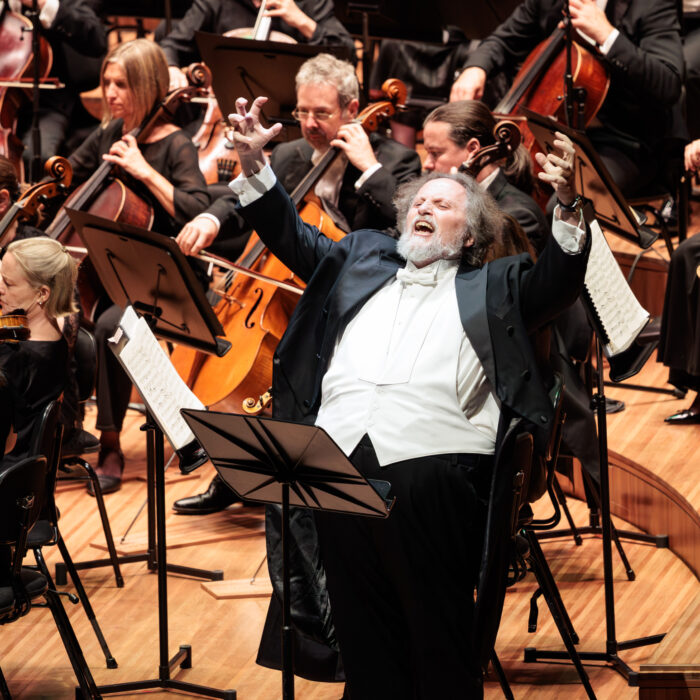
Opera Collective Ireland 2022 Review: Semele
A Young Cast Led By Christian Curnyn Brings Handel To Hollywood
By Alan Neilson(Photo: Frances Marshall)
Opera Collective Ireland’s mission is to promote the country’s next generation of opera talent “by producing quality productions that provide valuable performance opportunities in major roles.” Since its establishment in 2011 many singers have passed through its doors and gone on to establish successful careers, with names such as Jennifer Davis, Sarah Richmond and Marie Flavin springing to mind. The company’s choice of repertoire is by no means dull or focused on the standard favorites, rather it moves across genres, with productions ranging from Monteverdi’s “Il Ritorno di Ulisse” to Britten’s “Owen Wingrave, and takes in contemporary works such as “Vagabones” by Raymond Deane. The latest offering, which took place over the summer at the Kilkenny Arts Festival and in Dùn Laoghaire, was a production of Handel’s “Semele.”
With the composer having defined it as an oratorio rather than an opera, “Semele” received its premiere as part of Covent Garden’s 1744 Lenten concert season, and was performed as a concert without sets and costumes, with the soloists accompanied on stage by the chorus and orchestra. From a dramaturgical perspective, however, it is to all intents and purposes an opera, with the drama played out by the characters rather than through the chorus’ commentary. Since the work’s rehabilitation in the first half of the 20th century, it has often been presented as an opera, a form which has been enthusiastically received by the public.
From Ancient Greece To Hollywood
For this production the director Patrick Mason decided to move the setting from Ancient Greece to Hollywood in the mid-20th century, so that the gods became movie stars. And it worked quite well. Like the gods, they lived in luxury and operated outside the normal conventions of everyday people who stood in awe of their brilliance, so that when Semele was admitted to Hollywood they rejoiced in her good fortune.
The costumes, designed by Catherine Fay, were appropriate to the era, with smart suits for the men and suitably flashy dresses for Semele.
Paul Keogan’s sets were simple in their design, consisting of little more than a white deco style arch from which steps led down to the main performance area, with occasional props such as seats. Yet, it nevertheless managed to capture the essence of luxury and the time period of the setting, and more importantly provided a suitable background against which the drama was able to take place.
The intimate space of Dùn Laoghaire’s Pavilion Theatre, however, could not be said to be the perfect venue for this production. With only a small performing area, the singers had to operate in front of the orchestra, which had to be placed on either side of the steps, and through which the artists occasionally had to pass. At times, it made the performance space appear overly crowded, although never to the point of causing serious disruption. On the positive side, however, the compression of the action into a small space gave the production an intensity and immediacy which can be lost in larger theaters.
Given the aim of Opera Collective Ireland it would be wrong to expect the singers to be the finished article, but few could have been disappointed with the performances from this cast, who not only engaged enthusiastically with its parts, but also included some excellent individual performances, not least from Kelli-Ann Masterson in the title role.
Masterson Shines As Semele
Masterson is on the cusp of transitioning from an up and coming singer with potential to an established singer of recognized quality. This December she will be headlining as Norina in Irish National Opera’s production of “Don Pasquale.”
Her performance as Semele certainly confirmed her ability, whom she portrayed as suitably pleasure loving, spoilt and demanding. She possesses a wonderfully bright, flexible voice which she employs intelligently and with sensitivity, crafting delicate, ornate and detailed phrases. Moreover, she makes it appear so easy. In Act one, she laid down a marker with a bubbly rendition of the gavotte “Endless pleasure, endless love” in which her voice danced nimbly above the sound of the orchestra. However, it was her aria “Myself I do adore” which really showed off her capabilities as she unleashed a series of coloraturas, which not only highlighted her vocal versatility, but also the purity and beauty of her voice. Nor was it just the showpiece arias which impressed; her recitatives were also expertly delivered, displaying subtlety and clarity of expression.
Tenor Andrew Gavin was double parted as the gods Jupiter and Apollo. As Jupiter he appeared as a Clark Gable lookalike, acting out and singing the part with the necessary confidence and swagger. He possesses an attractive middle register which he used to good effect, but was let down when transitioning to his upper register which sounded awkward, and detracted from his overall performance. Recitatives were clearly and articulately delivered, underpinned by emotional depth, and arias were passionately, if not always securely, delivered.
Given that the goddess Juno actually disguises herself as Ino, it is normal for both parts to be essayed by the same singer. This was also the case on this occasion, with the roles essayed by mezzo-soprano Dominica Williams. In what was a satisfying performance, Williams engaged fully with her characters, so that they convinced as two separate distinct personalities, and successfully captured their very different emotions. She possesses a very colorful, versatile voice, which she employed expressively to portray Juno’s rage and Ino’s hope of love, coating her voice with the necessary feeling, which she accented imaginatively. She also displayed skill in ornamenting the vocal line, although in the more complex passages her projection became noticeably weaker, which on occasions undermined the quality of expression. Nevertheless, it was an enjoyable performance, full of passion and energy.
Another good performance came from bass Edward Hawkins, who was double parted as Semele’s father Cadmus, and the god of sleep Somnus. Possessing a voice with a pleasing timbre and singing with plenty of confidence, he displayed technical skill with his nicely crafted phrasing and flexible coloratura. His essaying of the role of Somnus also allowed him to show off his talent for comedy, with his portrayal of a god who really did not want to wake up.
Soprano Jade Phoenix displayed quality with an excellent performance in the role of Iris. In what is a relatively small part she managed to bring depth to her character with her expressively detailed phrasing and confident, secure approach, which she supported with her fine acting skills that captured the role’s underlying humor.
The countertenor Gerben van der Werf put in a solid performance as Athamas. In what was a technically secure presentation, he gave voice to his character’s hopes, frustrations and devastation, which allowed him to display the quality of his light, gentle, homogeneous voice, to which he occasionally introduced colorful inflections. While his singing was correct, and exhibited a high degree of precision, he would benefit from taking a more ambitious interpretative approach in order to enhance his dramatic expressivity.
The High Priest was played by chorus member bass Fionn Ó hAlmhain. Although only a small role at the beginning of the opera, he made a fine impression with a well-sung performance, which successfully captured his character’s authoritative manner.
The chorus Sestina consisting of ten singers was simply excellent. The singing was vibrant, clear, and sensitive to the dramatic dynamic. The textural contrasts it was able to produce were beautifully woven. Moreover, its small size was perfectly suited to the the size of the theatre.
The Akademie für Alte Musik Berlin under the musical direction of Christian Curnyn produced a sparkling account, which sat beautifully with the overall tenor of the production. It was lively and elegant, with a pleasing forward thrust. It was alert to the dramatic twists and turns of the narrative, whilst maintaining a good balance between the orchestra and singers.
Overall, this was a simple yet effective production with plenty to admire. Moreover, it acted as a fine example of the work being done by Opera Collective Ireland in promoting the next generation of artists. Undoubtedly, we shall be hearing a lot more of many of these artists in the future.



